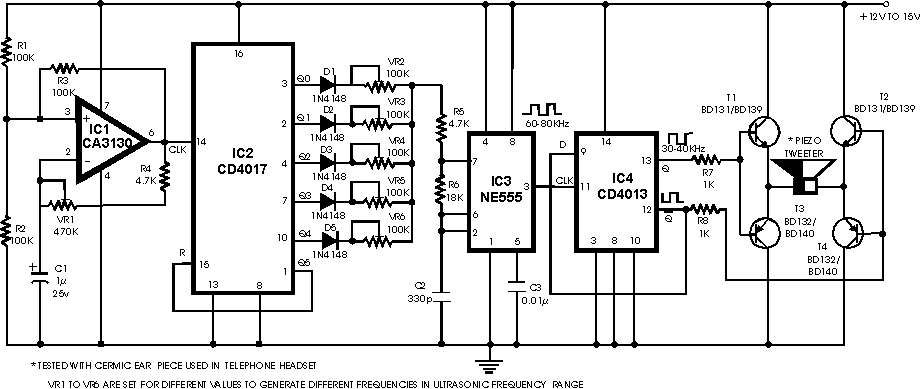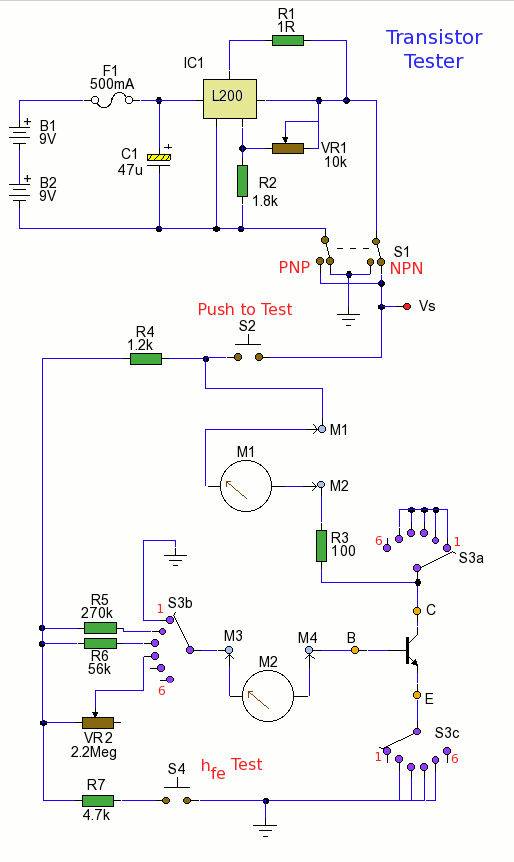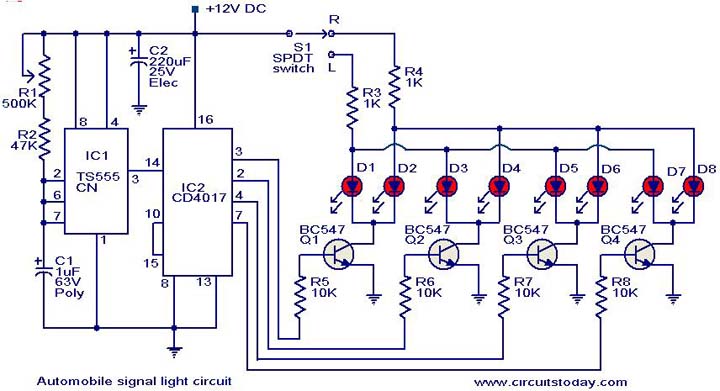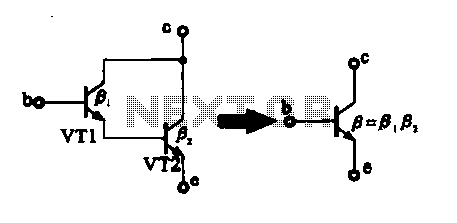
Please help with ultrasonic animal repeller circuit

A circuit diagram for an animal repeller is provided. The circuit has been developed but is not functioning as intended. Assistance is requested for troubleshooting.
The animal repeller circuit typically employs ultrasonic sound waves to deter animals from specific areas. The schematic generally includes a few key components: a power supply, an oscillator, a modulator, and a transducer.
1. **Power Supply**: This circuit is usually powered by a battery or a DC power source. The voltage requirements should be specified based on the components used, typically ranging from 5V to 12V.
2. **Oscillator**: The oscillator generates a high-frequency signal, which is often in the ultrasonic range (above 20 kHz). Commonly utilized components for this purpose include a 555 timer IC configured in astable mode or a microcontroller that can produce PWM signals. The frequency should be adjustable to cover different animal sensitivities.
3. **Modulator**: This section may include a transistor that amplifies the signal from the oscillator. The modulation can be achieved using a simple transistor switch that turns on and off at a specific frequency, creating a pulsing effect that can be more effective at repelling animals.
4. **Transducer**: The transducer converts the electrical signals into ultrasonic sound waves. Piezoelectric speakers are commonly used due to their efficiency in generating high-frequency sounds. The placement of the transducer is crucial; it should be positioned to maximize the coverage area.
5. **Additional Components**: The circuit may also include resistors, capacitors, and diodes for signal conditioning and protection. A potentiometer can be integrated to allow for frequency adjustment, enabling fine-tuning of the ultrasonic signal based on the specific environment or target animals.
For troubleshooting, one should verify the connections, check the power supply voltage, and ensure that all components are functioning correctly. Testing the output frequency with an oscilloscope can help determine if the oscillator is operating within the desired range. Additionally, ensuring that the transducer is operational and correctly positioned can significantly affect the circuit's effectiveness.HI FRIENDS, I HAVE A ANIMAL REPELLER CIRCUIT CIRCUIT DIAGRAM AS SHOWN: I HAVE WRKED ON THIS BUT NOT WORKING AS PREFERRED CAN U PLEASE CHECK THIS ONE.. 🔗 External reference
The animal repeller circuit typically employs ultrasonic sound waves to deter animals from specific areas. The schematic generally includes a few key components: a power supply, an oscillator, a modulator, and a transducer.
1. **Power Supply**: This circuit is usually powered by a battery or a DC power source. The voltage requirements should be specified based on the components used, typically ranging from 5V to 12V.
2. **Oscillator**: The oscillator generates a high-frequency signal, which is often in the ultrasonic range (above 20 kHz). Commonly utilized components for this purpose include a 555 timer IC configured in astable mode or a microcontroller that can produce PWM signals. The frequency should be adjustable to cover different animal sensitivities.
3. **Modulator**: This section may include a transistor that amplifies the signal from the oscillator. The modulation can be achieved using a simple transistor switch that turns on and off at a specific frequency, creating a pulsing effect that can be more effective at repelling animals.
4. **Transducer**: The transducer converts the electrical signals into ultrasonic sound waves. Piezoelectric speakers are commonly used due to their efficiency in generating high-frequency sounds. The placement of the transducer is crucial; it should be positioned to maximize the coverage area.
5. **Additional Components**: The circuit may also include resistors, capacitors, and diodes for signal conditioning and protection. A potentiometer can be integrated to allow for frequency adjustment, enabling fine-tuning of the ultrasonic signal based on the specific environment or target animals.
For troubleshooting, one should verify the connections, check the power supply voltage, and ensure that all components are functioning correctly. Testing the output frequency with an oscilloscope can help determine if the oscillator is operating within the desired range. Additionally, ensuring that the transducer is operational and correctly positioned can significantly affect the circuit's effectiveness.HI FRIENDS, I HAVE A ANIMAL REPELLER CIRCUIT CIRCUIT DIAGRAM AS SHOWN: I HAVE WRKED ON THIS BUT NOT WORKING AS PREFERRED CAN U PLEASE CHECK THIS ONE.. 🔗 External reference





